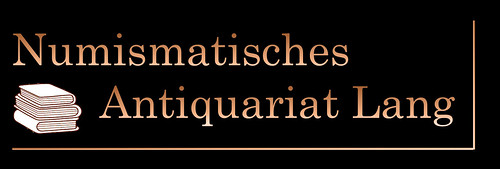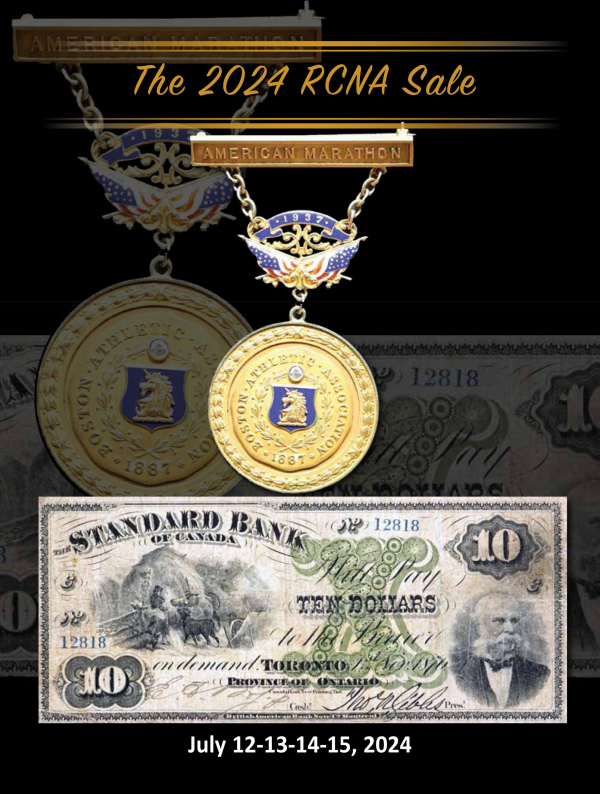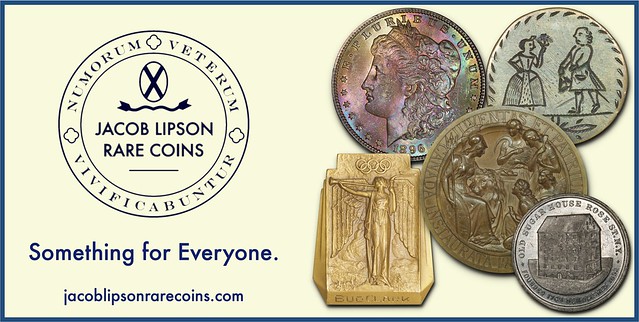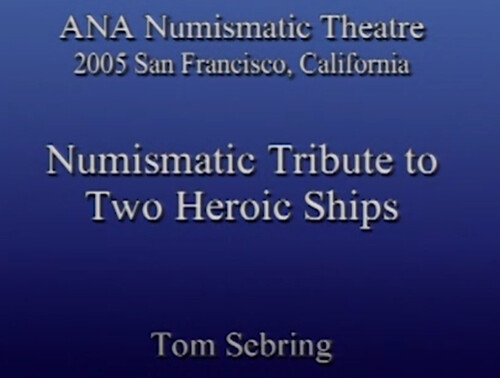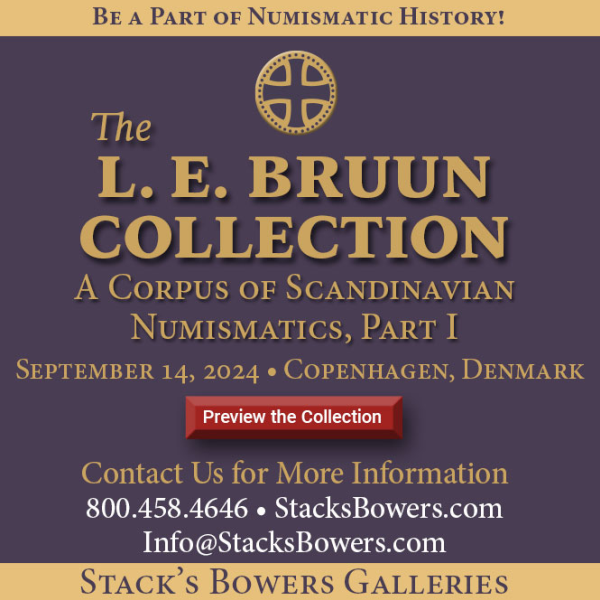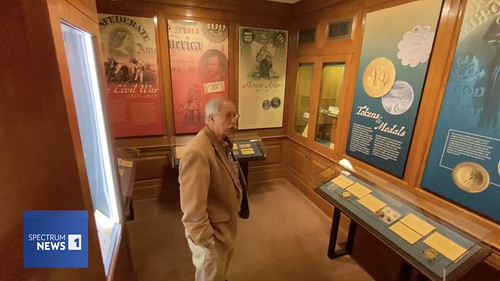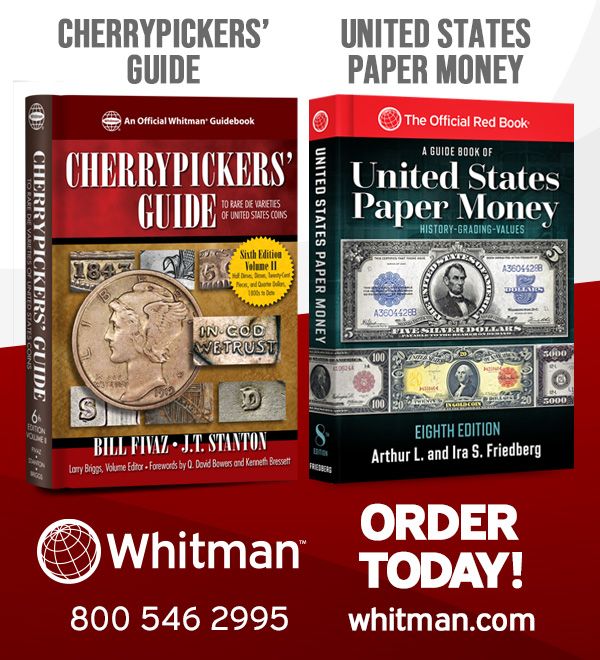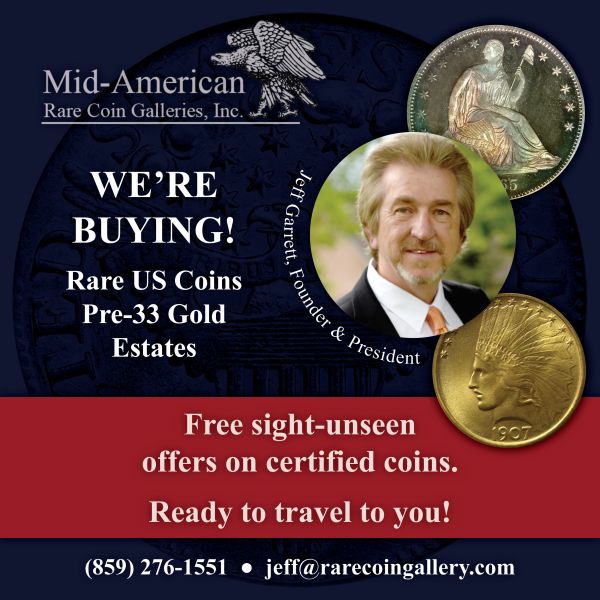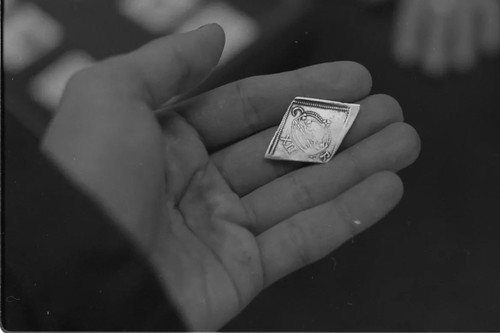
Visit our NBS Sponsors



About UsThe Numismatic Bibliomania Society is a non-profit association devoted to the study and enjoyment of numismatic literature. For more information please see our web site at coinbooks.org SubscriptionsThose wishing to become new E-Sylum subscribers (or wishing to Unsubscribe) can go to the following web page link MembershipThere is a membership application available on the web site Membership Application To join, print the application and return it with your check to the address printed on the application. Print/Digital membership is $40 to addresses in the U.S., and $60 elsewhere. A digital-only membership is available for $25. For those without web access, write to: Jeff Dickerson, Treasurer AsylumFor Asylum mailing address changes and other membership questions, contact Jeff at this email address: treasurer@coinbooks.org SubmissionsTo submit items for publication in The E-Sylum, write to the Editor at this address: whomren@gmail.com BUY THE BOOK BEFORE THE COINSale CalendarWatch here for updates! |
- WAYNE'S WORDS: THE E-SYLUM JULY 14, 2024
- LANG NUMISMATIC LITERATURE AUCTION 3
- NEW BOOK: LOCAL COINAGES IN A ROMAN WORLD
- NEW BOOK: NUMISMATIC HISTORY OF LOS ALTOS
- NEW BOOK: PAPER MONEY OF THE U.S., 23RD ED.
- NEW BOOK: EMERGENCY MONEY
- BANKNOTE BOOK CURACAO CHAPTER PUBLISHED
- RED BOOK IMPROVEMENTS TARGET MISINFORMATION
- RICHARD AUGUST (1940-2024)
- GREG BENNICK INTERVIEWS ERIC SCHENA
- VIDEO: TRIBUTE TO TWO HEROIC SHIPS
- CELLINI DIES FOR POPE CLEMENT VII MEDAL
- NOTES FROM E-SYLUM READERS: JULY 14, 2024
- NUMI V2.0 COIN IDENTIFIER & SORTER
- THE OFFSIDE RULE 50 PENCE
- VOCABULARY TERM: PORTRAITS AND PORTRAITURE
- STAN KESSELMAN INTERVIEW, PART FOUR
- ERIC SCHENA INTERVIEW, PART ONE
- NORTH CAROLINA MONEY DISPLAYED AT UNC
- EXHIBIT: MONEY TALKS
- STEPHEN ALBUM RARE COINS AUCTION 49 RESULTS
- WAYNE'S NUMISMATIC DIARY: JULY 14, 2024
- THE LEGENDARY SAN JOSE WRECK
- EXONUMIA
- ANS AWARD WINS AMERICAN MEDAL OF THE YEAR
- BREAD PICTURES NEW JAPANESE NOTES
- ARTIST SNATCHES BRITISH MUSEUM COIN
- LOOSE CHANGE: JULY 14, 2024
Content presented in The E-Sylum is not necessarily researched or independently fact-checked, and views expressed do not necessarily represent those of the Numismatic Bibliomania Society.
WAYNE'S WORDS: THE E-SYLUM JULY 14, 2024
 New subscribers this week include:
Wayne Rose, courtesy Roberto Jovel;
Mike McNeil, and
Ed Sarrafian.
Welcome aboard! We now have 7,266 subscribers.
New subscribers this week include:
Wayne Rose, courtesy Roberto Jovel;
Mike McNeil, and
Ed Sarrafian.
Welcome aboard! We now have 7,266 subscribers.
Thank you for reading The E-Sylum. If you enjoy it, please send me the email addresses of friends you think may enjoy it as well and I'll send them a subscription. Contact me at whomren@gmail.com anytime regarding your subscription, or questions, comments or suggestions about our content.
Many thanks to Garrett Ziss and our webmaster Bruce Perdue for minding the store while I was away last week. The issue was published on our website Sunday night as normal, and turned out great. But wouldn't you know it, that was the week our email provider changed something that kept the email notification from going out to everyone. I made a call to their support desk from a mountaintop in Switzerland, and Bruce was able to figure out what happened and get the email out in short order. Thanks!
This week we open with a numismatic literature sale, four new books, tributes to a colonial coin legend, updates from the Newman Numismatic Portal, and more.
Other topics this week include the banknotes of Curacao, notes from readers, portraits, interviews, numismatic exhibits, auction results, the San Jose wreck, exonumia, and another theft from the British Museum.
To learn more about coins in the Early Roman Provinces, the numismatics of the state of Los Altos, the art history of German Notgeld, Richard August, Eric Schena, Tom Sebring, counterfeit Walking Liberty half dollars, the 50 pence “offside rule” coin, North Carolina money, and the 2024 American Medal of the Year, read on. Have a great week, everyone!
Wayne Homren
Editor, The E-Sylum
LANG NUMISMATIC LITERATURE AUCTION 3
The third numismatic literature auction from Numismatic Antiquarian Bookshop Lang closes July 31, 2024. Here's the announcement. -Editor
Dear collectors and lovers of numismatic literature,
We are pleased to inform you that the Numismatic Antiquarian Bookshop Lang will be holding its third literature auction on July 31, 2024.
- Date: July 31, 2024
- Location: Live auction via Auex - click here to register
- Time: Start at 17:00 CEST
Alternatively, you can also use the auction platforms Biddr and Sixbid to place your pre-bids. The platforms will be activated on Monday, July 15, 2024 at the latest.
Please note that this auction will take place on a Wednesday.
THE BOOK BAZARRE
NEW BOOK: LOCAL COINAGES IN A ROMAN WORLD
A new book by Lucia Carbone based on coins in the Rick Witschonke collection has been published by the American Numismatic Society. See the earlier article for additional information. -Editor
Local Coinages in a Roman World, Second Century BC–First Century AD
A Catalogue of the Richard B. Witschonke Collection of Coins in the Early Roman Provinces
by Lucia F. Carbone
with Oliver D. Hoover, Suzanne Frey-Kupper, Clive Stannard, Sophia Kremydi, Federico Carbone, David Hendin, and Liv M. Yarrow, and with special contributions by Douglas Wong and Alice Sharpless
Volume 1: Text | Volume 2: Plates
NEW BOOK: NUMISMATIC HISTORY OF LOS ALTOS
A new book by Roberto Jovel examines the numismatics of the state of Los Altos. Here's the announcement. -Editor
NUMISMATIC HISTORY OF THE STATE OF LOS ALTOS IN THE CENTRAL AMERICAN
FEDERATION, 1838-1840
Roberto Jovel
 A new, bilingual, English/Spanish book on the numismatics of the short-lived State of Los Altos
in the Central American Federation is now available. It describes medals and a number of
counter stamped coins issued by the State of Los Altos, and the historical, political, economic
and social conditions that prevailed at the time.
A new, bilingual, English/Spanish book on the numismatics of the short-lived State of Los Altos
in the Central American Federation is now available. It describes medals and a number of
counter stamped coins issued by the State of Los Altos, and the historical, political, economic
and social conditions that prevailed at the time.
Since the XVIII Century and well into the XIX Century, the region of Los Altos in the western part of Guatemala sought independence from the State of Guatemala. This region was inhabited by cachikel Indians and Spanish descendants. These peoples resented the strict dominance imposed on them by the powerful traders located in Guatemala City, and the lack of adequate infrastructure to transport and export their products abroad. Just before independence in 1821-23, Los Altos formally requested recognition as a separate political entity. When the Central American Federation was formed in 1824, no decision was adopted to accept such a request. In 1838, the State of Guatemala was under political chaos, and the Los Altos peoples decided to secede and create its own State. Later in that year, the Central American Congress approved the Los Altos request to become a full member of the Federation.
NEW BOOK: PAPER MONEY OF THE U.S., 23RD ED.
The latest edition of Paper Money of the United States has been announced. Here's the press release. -Editor
 Seventy-one years after its introduction, the twenty-third edition of Paper Money of the United States, the standard reference book on American currency, is being released by the Coin & Currency Institute in July 2024. In 1953, the late Robert Friedberg (1912-1963) broke new ground when the Treasury Department granted permission for photographs of American paper money to be printed for the first time. The current edition's 336 pages feature notes from America's greatest currency collections, as well as most of the greatest rarities, all reproduced in color.
Seventy-one years after its introduction, the twenty-third edition of Paper Money of the United States, the standard reference book on American currency, is being released by the Coin & Currency Institute in July 2024. In 1953, the late Robert Friedberg (1912-1963) broke new ground when the Treasury Department granted permission for photographs of American paper money to be printed for the first time. The current edition's 336 pages feature notes from America's greatest currency collections, as well as most of the greatest rarities, all reproduced in color.
The inaugural edition of Paper Money of the United States also introduced other innovations never before attempted. The subject became standardized, and the book earned a permanent place on reference shelves. During the past four decades, it has been completely expanded, revised, and edited by Arthur L. Friedberg and Ira S. Friedberg.
The twenty-third edition of Paper Money of the United States, as any price catalog, is a snapshot in time – and as the new edition debuts, it shows that the market for paper money is stable or rising in all categories. Notes of great rarity or top quality are often establishing price records every time they are sold. All valuations in the new edition have been adjusted, mostly upward, to reflect market conditions. These prices are given in up to seven states of preservation from Very Good (VG8) to Gem Uncirculated (Gem65). A major addition is the expansion of the section on the Treasury Notes of the War of 1812 to include those issued from 1837 to 1860. There are also several other additions and revisions to the new volume, including notes never known to exist, making it a necessity for every collector and dealer of American currency.
NEW BOOK: EMERGENCY MONEY
A new book examines the art history of German Notgeld. -Editor
Emergency Money: Notgeld in the Image Economy of the German Inflation, 1914–1923
by Tom Wilkinson (Author)
 A landmark art historical study of German Notgeld, the emergency money produced during World War I, and the hyperinflation that followed.
A landmark art historical study of German Notgeld, the emergency money produced during World War I, and the hyperinflation that followed.
Emergency Money is the first art historical study of Germany’s emergency money, Notgeld. Issued during World War I and the tumultuous interwar period, these wildly artful banknotes featured landscapes, folk figures, scenes of violence and humor, and even inflation itself in the form of figures staring into empty purses or animals defecating coins. Until now, art historians have paid Notgeld scant attention, but Wilkinson looks closely at these amusing, often disturbing, artifacts and their grim associations to cast new light on the Weimar Republic’s visual culture, as well as the larger relationship between art and money.
BANKNOTE BOOK CURACAO CHAPTER PUBLISHED
A new chapter of The Banknote Book has been published by Whitman-CDN. Written by Mark Irwin and Owen Linzmayer, the 24-page catalog covers 149 varieties of Curaçao notes issued from 1827 to 1948. -Editor
RED BOOK IMPROVEMENTS TARGET MISINFORMATION
In a recent article for the Numismatic Guaranty Company (NGC), Jeff Garrett discusses the "Fake News and Numismatic Misinformation" that abounds online today. Here's an excerpt where he mentions some upcoming improvements to the Red Book seeking to better inform the general public. -Editor
Recently, the new owners of the “Red Book” hosted a multi-day summit to discuss ways to improve the Guide Book of United States Coins (Red Book). One of the topics included a discussion about including more detailed information and illustrations referencing coin grading. There are plans to more fully explain the vast jump in prices for coins from one grade to the next.
Also, we will include information about ultra-grade coins and why they bring so much. The Red Book has a tremendous amount of information for those unfamiliar with the hobby. The reference will need to include a robust section about misinformation.
RICHARD AUGUST (1940-2024)
This weekend the Google colonial coins email group carried tributes to collector/dealer Dick August, who passed away on Saturday, July 13, 2024. Sorry to hear the news. With permission, several of these notes are republished here. Per Jim Rosen, Dick was born May 10, 1940. Craig McDonald provided the photo of Dick taken at the 2009 Colonial Coin Collectors Club (C4) convention. -Editor
"It is with profound sadness that I relate to you all that my friend Dick August died today at 12:05 PM at the age of 84. Dick and I were close friends since we first met in January of 1990 and I will miss him greatly."
Mike Packard writes:
"Sad news. Dick was always very very kind to me in sharing his knowledge of the finer aspects of colonial coins. I will miss him. "
GREG BENNICK INTERVIEWS ERIC SCHENA
Newman Numismatic Portal Project Coordinator Len Augsburger provided the following report. -Editor
 Eric Schena, a well-known fixture in the numismatic research fraternity, specializes in “off the beaten path” material, with an emphasis on numismatic items of the mid-Atlantic region. He is especially focused on merchant tokens and scrip, which are often the only surviving artifacts of long-forgotten commercial enterprises. Given the geographical area, there is significant crossover with coal mines and related company stores.
Eric Schena, a well-known fixture in the numismatic research fraternity, specializes in “off the beaten path” material, with an emphasis on numismatic items of the mid-Atlantic region. He is especially focused on merchant tokens and scrip, which are often the only surviving artifacts of long-forgotten commercial enterprises. Given the geographical area, there is significant crossover with coal mines and related company stores.
Unlike the U.S. Mint, which centralizes information related to federal coinage, token researchers have to cast a wider net, with the Ingle-Schierloh records being one important source of information. This firm manufactured tokens for hundreds, if not thousands of firms, and some of their records survive. These confirm the low mintages of many issues, and it is not uncommon that examples survive to the extent of ten or fewer pieces. Unlike federal coins, however, these can often be acquired at remarkably low prices.
Schena also looks to old business directories, many of which he has on microfiche. Few researchers can claim to own their own microfiche reader, and Schena takes his place among this elite group. Ebay contains its own needles in a haystack, and Eric discusses the lucky acquisition of a 19th century bank minutes book.
Newman Portal acknowledges Greg Bennick, who has now contributed ten interviews, capturing stories of collectors past and present. Coin collectors are in many ways historians, and even those not involved in the research side of the hobby act as curators and stewards for the next generation of those to come.
VIDEO: TRIBUTE TO TWO HEROIC SHIPS
The David Lisot Video Library on the Newman Numismatic Portal can be found at:
https://nnp.wustl.edu/library/multimediadetail/522852
We highlight one of his videos each week in The E-Sylum. Here's one from 2005 with Tom Sebring speaking about a numismatic tribute to two allied ships sunk by the Japanese in WWII. -Editor
CELLINI DIES FOR POPE CLEMENT VII MEDAL
John Cadorini submitted these notes on the dies for a medal honoring Pope Clement VII. Thank you. -Editor
Although I read every newsletter as released, I seldom find articles upon which to comment. The one on the Bargello is different in that I recently contacted them with an inquiry about certain Renaissance dies created by Benvenuto Cellini. I first emailed the Vatican collections to ask if the dies created by Cellini for medals honoring Pope Clement VII were in their collections. They promptly responded that the dies are held in the Bargello collections and upon an email to their curator photos were sent to me of the two main dies in question .. obverse and reverse of a medal commemorating the Treaty of Cambrai which ended the conflict between Spain and France fought in the Italian states.
My interest in these was due to a recent CNG Electronic auction containing a restrike example if the original medal using Cellini s original dies . Attached are images of the CNG example and of the two dies as well. Even greater was my delight to find how promptly my inquiries were answered by two such large institutions.
NOTES FROM E-SYLUM READERS: JULY 14, 2024
More on Ceylon Banknotes
Kavan Ratnatunga submitted this update and request for information on the Banknote Book Ceylon chapter. Thanks. -Editor
 Owen Linzmayer published a new edition of the Banknote Book Ceylon Chapter expanding the section on banknotes issued before 1885 from 2 pages to 32 pages in collaboration with Kavan Ratnatunga, using the information and images compiled by him in
http://notes.lakdiva.org
Owen Linzmayer published a new edition of the Banknote Book Ceylon Chapter expanding the section on banknotes issued before 1885 from 2 pages to 32 pages in collaboration with Kavan Ratnatunga, using the information and images compiled by him in
http://notes.lakdiva.org
See the announcement at https://banknotenews.com/?p=44427
The New edition now has all of the known notes issued before 1885 by the Dutch VOC from 1785 to 1796, the Government of Ceylon Treasury from 1801 to 1856, and the Various Private Banks in Ceylon from 1844 to 1884 which were considered wrongly by Pick and subsequently by Krause SCWPM as specialized issues.
Also added were the few Ceylon essays that were printed like banknotes on both sides with dates 1938-7-1, 1951-1-20 with King George VI, and 1972-5-22 with Mrs. Sirimavo Bandaranaika, which were never issued, increasing the number of notes in this category in the Ceylon Chapter of the Banknote book from 3 to 10.
If anyone has a Ceylon Banknote not listed now in the new catalog or my website http://notes.lakdiva.org please let Owen and kavanr@gmail.com know with 300 dpi images for inclusion in the Banknote book Ceylon Chapter and my website.
To read the earlier E-Sylum article, see:
BANKNOTE BOOK CEYLON CHAPTER PUBLISHED
(https://www.coinbooks.org/v27/esylum_v27n27a03.html)
Other topics this week include the Metis People, Counterfeit Walking Liberty Half Dollars, and the TAMS “Ask the Experts” ANA Forum. -Editor
NUMI V2.0 COIN IDENTIFIER & SORTER
Last year Justin Hinh created an app using OpenAI's ChatGPT platform to provide coin identification and grading estimates. Here's his latest update. See the links below for earlier articles. -Editor
 I finally have an update to share with readers on the next iteration of Numi.
I finally have an update to share with readers on the next iteration of Numi.
After playing around with AI coin grading for half a year, I've started to sour on the idea. I think Technical Grading will eventually be accurate enough to be useful, but I don't think the market will accept it. PCGS, NGC, and CAC are just too dominant. People want and trust the judgment of these companies. I just can't see AI grading taking off in a big manner.
But...after testing AI's computer vision capabilities over a thousand times, I noticed that it's extremely accurate in identifying coins 99% of the time. Specifically identifying the series, year, and mintmark. [For US and World Coins, not medals or tokens. Nor varieties/errors]
THE OFFSIDE RULE 50 PENCE
David Pickup submitted these notes on the 2011 50 pence “offside rule” coin. Thanks. -Editor
Come on England!
The England football team is in the Euros Final tonight playing Spain. Fans of the game have dreamed about winning a major title since the 1960s. There are many different world coins which feature sports and football but thirteen years ago the Royal Mint issued a coin which does not relate to a competition but highlights a rule in the game.
Football’s “offside rule” is explained on a 50 pence coin dating from 2011. It is one of scarcer 50p commemorative coins with a circulating mintage of 1,125,500. One site lists it as very scarce.
VOCABULARY TERM: PORTRAITS AND PORTRAITURE
Here's another entry from Dick Johnson's Encyclopedia of Coin and Medal Terminology. I added a medal image from the Benjamin Weiss collection. -Editor
Portraits and Portraiture. The image of a human being showing enough characteristics – usually the face – to identify that person, and the study of these images on coins and medals in history. If the most important function of coins is to serve as a medium of exchange, the second most important aspect of coins and medals is their contribution to portraiture. We can observe portraits made centuries ago (and certainly before photography existed to record their exact images) to reveal images of human beings of the past.
These likenesses reveal the features of people of history, some obscure, some most prominent. Statues and paintings were created as image-recorders of the past, but not one Greek portrait painting has survived and most early statues are disfigured or have crumbled in time. Coins and medals have a greater capacity for survival, over longer time, than does any other medium of recording the personal image!
STAN KESSELMAN INTERVIEW, PART FOUR
Greg Bennick's latest interview for the Newman Numismatic Portal is with New York dealer Stan Kesselman. Here's the fourth part, where Stan talks about Harry Bass, Mike Brownlee and a frightening bottle of Champagne. -Editor
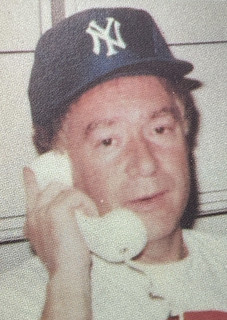 STANLEY KESSELMAN: So, the last story I want to tell you.
STANLEY KESSELMAN: So, the last story I want to tell you.
GREG BENNICK: Yeah, please do. I'm just glad Harry Bass started to talk to you again. That's great.
STANLEY KESSELMAN: Oh, we were very friends. He went out with me on the first date I was with my wife.
GREG BENNICK: Really?
STANLEY KESSELMAN: Yeah. And the story with that is a personal story. I'm at 62nd Street and Park Avenue walking my first date back to her place. And she says she has to go to the bathroom, which women do a lot. And I said, we're at 62nd and Park. There's a Regency hotel. I have one of my employees stay in there. We can go up to his room and use his bathroom. And she says, all right. And she says, “I can use the bathroom in the lobby.” And I said, “Yeah, go up to the room. Don't worry.” So, I get on the house phone. I said, “Harry, we're coming up. I'm with this girl. She wants to use the bathroom.” He says, “Come on up.” So, we go up to Harry's room. The Regency is a high-class hotel. He's wearing a cashmere bathrobe. She goes and uses the bathroom. It's the first bathroom I’ve ever seen with a telephone in it on the wall. And comes out. I said, “This is my employee. Her name is Sharon. I'm Harry Bass.” He was so sophisticated. They were talking back and forth. He knew she was not my employee. He figured that out in five minutes. I mean, he had so much more money and so much sophistication than I did.
GREG BENNICK: Yeah.
STANLEY KESSELMAN: So, we all went to Maxwell's Plum to get something to eat. And then I walked her home.
GREG BENNICK: Amazing.
STANLEY KESSELMAN: Yeah. So, he was with me when I had my first date with my present wife.
GREG BENNICK: That's great. That's great.
STANLEY KESSELMAN: And we were all very friendly for a long, long time. My last story that I can tell is when Mike Brownlee and Johnny Rowe were in St. Louis. And we're staying in a hotel that was built 100 years ago. And how they got my bed into the room was an act of physics. The bed was the size of the room. And the hotel was in a very bad neighborhood. So we go to the auction. And Brownlee and Rowe say to me, why don't we split the auction up instead of bidding against each other?
So, one of us bought the coins. And at the end of the auction, we put all the coins in a paper bag. And whatever you pull out of the paper bag is yours.
GREG BENNICK: Wow.
STANLEY KESSELMAN: So, they said, “Stanley, you go first.” I said, “Fine. No big deal.” I put my hand in there. I pull out a coin. All right. That's my coin. Mike Brownlee goes next. He puts his hand in the bag and pulls out a coin. Then Johnny Rowe puts his hand in the bag and pulls out a coin. I said, “Wait a second here. You guys are getting two coins for my one coin.” I said, “That's not fair.” And they said, “Stanley, you really figured that out, didn't you?” So, they started to laugh. And we split the bag, you know, 50-50.
GREG BENNICK: That's great.
STANLEY KESSELMAN: And then Mike Brownlee says to me, “You know, everybody's watching us at the auction. They saw us buy all the coins. You better be careful tonight. You better lock your door in the room. And we'll meet for breakfast tomorrow morning.” OK. I go to the room. I have half my coins. And at 2.30 AM, there's a knock on my door. I say, “Who is it?” He says, it's the water that I ordered for my party, ice water. And there's a bottle of champagne in it. And I said, “Listen, I wasn't going to open that door for anybody at any time.” I said, “Listen, I have a gun in here. I'm going to count to three. I'm going to open the door then. I'm going to shoot first and then see who you are.” I'm scared out of my wits.
GREG BENNICK: Yeah.
STANLEY KESSELMAN: So, I count one. I count two. And I hear footsteps going away. So, five to 10 minutes later, I get the courage to open the door. And there's no champagne, but there's melted ice water in a big bucket.
GREG BENNICK: Wow.
STANLEY KESSELMAN: And I said, “Wow, I am so smart.” Scared the hell out of me. So, I go down to breakfast, 9 in the morning. I meet Michael. And he says to me, how's my night go? I said, “Michael, you're a genius. They tried to come and get me and get my coins.” And Michael says, “Do you mean the boy with the ice water that I sent?” He sent them. Scared the hell out of me, let me tell you.
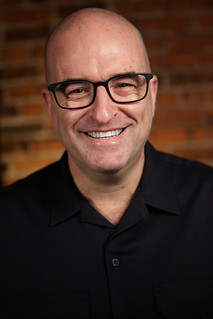 About the Interviewer
About the Interviewer
Greg Bennick (www.gregbennick.com) is a keynote speaker and long time coin collector with a focus on major mint error coins. Have ideas for other interviewees? Contact him anytime on the web or via instagram @minterrors.
To watch the complete video, see:
Stanley Kesselman Interviewed for the NNP by Greg Bennick
(https://nnp.wustl.edu/library/book/638521)
To read the complete transcript, see:
Stanley Kesselman Interviewed for the NNP by Greg Bennick (Transcript)
(https://nnp.wustl.edu/library/book/638520)
To read the earlier E-Sylum article, see:
STANLEY KESSELMAN INTERVIEW, PART ONE
(https://www.coinbooks.org/v27/esylum_v27n25a06.html)
STANLEY KESSELMAN INTERVIEW, PART TWO
(https://www.coinbooks.org/v27/esylum_v27n26a13.html)
STANLEY KESSELMAN INTERVIEW, PART THREE
(https://www.coinbooks.org/v27/esylum_v27n27a11.html)
ERIC SCHENA INTERVIEW, PART ONE
Anther of Greg Bennick's interviews for the Newman Numismatic Portal is with exonumia researcher and collector Eric Schena. Here's the first part, where Eric talks about his diverse collecting interests. -Editor
GREG BENNICK: Awesome. Well, just a little background, everybody. Eric and I met last year at the ANA show. Is that right? Yeah, I think it was at the ANA.
ERIC SCHENA: That is correct.
GREG BENNICK: Yep, at the ANA show. So, we struck up a conversation because we had a connection through the Token and Medal Society, both an interest in tokens and metals, but also a literal connection, a person, Dave Schenkman, through the Token and Medal Society, and we started chatting. Well, within the first five minutes of chatting, from my side of the conversation, as I was asking Eric, as I often ask people, “What do you collect? What are you interested in?” Eric had given me a list of things, and where normally somebody will say something that I can relate to, collect, or I'm interested in, the list of things that Eric was absolutely fascinated by were either things I'd never heard of, things I never imagined collecting, and I was immediately interested. So, I said, let's do an interview, and this can be almost a 101 for people like me who have no idea about some of the things that you find interesting. So, I'm really glad that we get a chance to talk today.
ERIC SCHENA: I am too. Thank you for having me on.
GREG BENNICK: Absolutely. So, let's put ourselves back at the ANA. We're standing on the bourse floor, and you don't have to remember word for word, but I ask you, so Eric, I mean, you're on the Board of Directors, the Board of Governors, is it, of TAMS, or Board of Directors?
ERIC SCHENA: Board of Governors.
GREG BENNICK: Board of Governors.
ERIC SCHENA: It's technically Board of Governors, but we're basically Board of Directors.
GREG BENNICK: Yep. So, you're on the board at TAMS, and you've won a number of awards, a Mishler Cataloging Award. You've won, I think, is it named after Dave Schenkman, the Dave Schenkman Literary Award?
ERIC SCHENA: Yes. I won a Dave Schenkman Literary Award, as well as the bronze version of that as well.
GREG BENNICK: I love it. So, there you go. So, I’ve got that much of a background. We're standing on the bourse floor, and I ask you, so Eric, “What do you collect?”
ERIC SCHENA: Oh, I collect basically the items that are off the beaten trail. The path less traveled would probably be the best description for it. My primary hobby is, my primary focus in collectibles, is the numismatic history of the Mid-Atlantic region, which is primarily Virginia, which is the state that I call “my adopted home,” Maryland, D.C., Delaware, North Carolina, and West Virginia. Those are my core states.
And by numismatics of those states, I am talking about the early paper money, colonial paper money, fiscal instruments, tokens, store scrip, picker’s checks, all sorts of things of that kind, and including foreign coins that circulated here in the Mid-Atlantic prior to the establishment of the U.S. Mint. So, I run the whole gamut, and a little bit of national currency, and a little bit of national bank notes. Though, that sometimes gets a little bit out of my price range, so I don't have that many from my area.
GREG BENNICK: So, of that list, where do you think your main focus or area of expertise is in particular? Is it each and all of those things, or is it one in particular or a few in particular?
ERIC SCHENA: I would have to say it is probably store tokens, general store tokens and coal scrip, mining scrip. That is my primary area of expertise, with a side expertise in pre-Civil War paper money as well. And when it comes to pre-Civil War paper money, that is almost exclusively in relation to the state of Virginia, including the counties that now comprise the state of West Virginia.
GREG BENNICK: Did you work on the Virginia Tokens book with Dave Schenkman?
ERIC SCHENA: I did indeed, the second edition. I helped him with the cataloging there as well as doing the layout and arranging it and going around out in the field trying to find some new tokens to list and also photographs of some of the stores and other related artifacts. One of the things that I find particularly fascinating with store tokens is, unlike, say, a 1909 VDB penny, store tokens, you can pretty much tell exactly where it was used and, in some cases, who used the token. Like, you could put names to these people.
And I like to go and try and get some of that history because a lot of it is what an architecture person would call vernacular. It wasn't meant to last. It was purely utilitarian. And a lot of that history has disappeared, in particular with general stores and coal mining camps. You will find with coal mining camps, especially, they're ghost towns. Now the famous ghost towns are all out west because of the gold and silver rushes and things like that. But there are ghost towns in the east, too. And they vanish and no one will have any kind of notion that it was even there, except, in many cases, the tokens.
GREG BENNICK: That's pretty amazing.
ERIC SCHENA: Yeah, it's really kind of interesting. If you don't mind me doing a little bit of show and tell here.
GREG BENNICK: Please do and if you can add a slight bit of light to you, as you do, we might be able to see things better.
ERIC SCHENA: Yeah, let me see what I can do about that.
GREG BENNICK: There you go. Now, I noticed that Mischief walked away as soon as we started talking about coins. Is that representative of Mischief not enjoying coins or…
ERIC SCHENA: Yeah, she's probably bored stiff. It's all right. Yeah, she's got a cat bed up on my desk. I actually have several cat beds. My wife and I both have a bunch of rescue cats. So, we've taken care of them. But, yeah, one of the things I wanted to show was about general stores out here is, like, for instance, this is a town called Henry. And Henry is in Mineral County, West Virginia. I should say was in Mineral County, West Virginia. There is quite literally nothing there now. It was a coal camp that lasted maybe about 15, 20 years or so. And there are no tokens from Henry, but this is a book of coupons that were used at the company store, just like the coal scrip. And no one would even know where Henry, West Virginia was if it wasn't for something like this and people trying to preserve that history.
And so, part of what I did for Dave was go around and look for some of the store buildings and identify them and photograph them before they were gone. And in one case in particular, the store did in fact, disappear not long after I took photos of it, and it was in the, and it's in the book now, it was a store in a place called Rileyville, Virginia, which is in Page County. It butts up against what is now Shenandoah National Park or Skyline Drive, and it was a store building that was not long after I took photos of it, it got paved over for a church parking lot.
So, that's the type of thing that's important to go around and document and that's one of the reasons why I specialize in this type of thing with tokens and scrip, is many of these buildings they disappear and the history just disappears with them.
 About the Interviewer
About the Interviewer
Greg Bennick (www.gregbennick.com) is a keynote speaker and long time coin collector with a focus on major mint error coins. Have ideas for other interviewees? Contact him anytime on the web or via instagram @minterrors.
To watch the complete video, see:
Eric Schena Interviewed for the NNP by Greg Bennick
(https://nnp.wustl.edu/library/book/639081)
To read the complete transcript, see:
Eric Schena Interviewed for the NNP by Greg Bennick (Transcript)
(https://nnp.wustl.edu/library/book/639095)
NORTH CAROLINA MONEY DISPLAYED AT UNC
A new exhibit at the University of North Carolina highlights that state's coins and currency. Found via News & Notes from the Society of Paper Money Collectors (Volume X, Number 4, July 9, 2024). -Editor
Schreiner is the curatorial specialist for the exhibit of North Carolina money inside Wilson Library at UNC Chapel Hill.
“But to, to just see how much different things were in the past than they are in the present is sort of the essence of history. And we learn to some extent to compare what we do today with what was done in the past,” Schreiner said.
He explained colonies controlled by Great Britain weren’t allowed to make their own money before the Revolutionary War.
EXHIBIT: MONEY TALKS
A new exhibit opening August 9, 2024 at the Ashmolean Museum in Oxford examines how currency and art come together in design and culture. -Editor
Exploring the place of money in our world through different artistic lenses.
Money Talks will reveal how currency and art come together in design and culture to promote or challenge our views. It will feature works by some of the best-known artists, from Rembrandt to Warhol.
Most of the imagery on our currency begins its life as art, before being mass produced on coins and notes. It has a dramatic impact on what and who we imagine is valuable.
Money itself is a popular theme in art – artists have long explored and commented upon the balance between power, wealth and plenitude through using money artistically in novel ways.
STEPHEN ALBUM RARE COINS AUCTION 49 RESULTS
Here's a press release with some results from the recent Stephen Album Rare Coins Auction 49. Nice coins. -Editor
Stephen Album Rare Coins held its Auction 49 on June 13-16, 2024, at its o?ces in Santa Rosa, California. Solid prices were realized, with the total coming to $2.80 million (including buyer’s fees) on an estimate of $2.17 million. The sell-through rate was 90.6%.
A few highlights from the auction follow (prices include buyer’s fees):
WAYNE'S NUMISMATIC DIARY: JULY 14, 2024
OK. very little numismatics this week, but a number of you have asked about my trip to Switzerland, so here's a quick update with a smattering of coin stuff. Overall, it was a wonderful trip. Switzerland is a very pretty country. We walked all over Geneva the first day, and for our wedding anniversary on the 7th we all went over to Annecy, France, which was lovely - a beautiful town near a beautiful lake. There were nine people from two families in our group. We stayed three days in a house in Grindelwald and visited Interlochen, too. We saw Lusanne on the way to Zurich.
Seven of us went to the Taylor Swift concert. The girls and their Moms got in line around 8:30am and ended up just a couple standing spots away from the central stage. The menfolk had VIP tickets near the far end of the stage. We didn't have to arrive so early, but we went anyway as a support crew for the women. We brought them food and souvenirs while they held their spots in line. The crowds were insane, but well-behaved. Despite the long day, the girls loved the concert - "Best night ever".
THE LEGENDARY SAN JOSE WRECK
Peter Jones has published an article about the 1708 San José shipwreck on his website. It's a handy summary of significant events to date. See the article online for links to sources and images. -Editor
The Legendary San José Wreck 1708: A Tale of Treasure, Tragedy, and Deceit
In 1708, amid the tumult of the War of Spanish Succession, British ships battled the Spanish galleon San José galleon off Cartagena, Colombia. They knew immense riches were on board. But the evening after an exchange of fire, her powder magazine suddenly exploded, and she sank. Estimates suggested she carried 7 to 11 million pesos (190 to 300 tonnes of silver), 11 million gold coins (around 70+ tonnes of gold), and a bounty of emeralds. She is the holy grail of shipwrecks worth $4 billion to $20 billion. Her exploration has gone in fits and starts since 1981, besieged by legal fights. Spain, Colombia, Bolivia, Peru, Panama, and the salvage company, Sea Search Armada, have all claimed her riches. Her immense treasures have fired tribal wars between archaeologists and treasure hunters. Let’s explore her saga:
Timeline of the San José
1698: Spain launched the San José, a majestic 3-masted, 1051-ton, 131-foot, 62-gun galleon.
1701-1714: The War of Spanish Succession raged. As the childless Carlos II of Spain lay dying in 1700, he appointed the French Bourbon, Philip as successor. Fearing this French and Spanish alliance, Britain, Austria, and the Dutch Republic started the War of Spanish Succession. After millions of deaths, the 1713 Treaty of Utrecht dictated Philip V remain king of Spain, but he had to renounce future claims to the French throne.
EXONUMIA
A short Antiques column in the Desert Sun of Palm Springs, CA takes a look at exonumia. It's nice to see this in the popular press. -Editor
Here's a word you don't hear very often: exonumia. While it sounds like one of those weird names given to new drugs, exonumia is actually a subset of coin collecting. It's a name for the category of tokens, medals and scrip that are not currency but serve rather as promotional or "good for" exchanges. There are hundreds of different types from badges to medallions, tags to challenge coins, souvenir pennies to wooden nickels. It's an interesting category of numismatics and one that generally involves a modest investment to get started. Let's spend a few minutes to see what it's about.
ANS AWARD WINS AMERICAN MEDAL OF THE YEAR
Jon Radel forwarded this announcement from the American Medallic Sculptors Association. Thanks. -Editor
The American Medallic Sculptors Association (AMSA) has announced that Eugene Daub won the 2024 American Medal of the Year (AMY) award, for medals created in 2023, for his award medal commissioned by the American Numismatic Society (ANS). The American Numismatic Society confers the Huntington Award annually in honor of the late Archer M. Huntington, benefactor and President of the American Numismatic Society from 1905-1910, and commissioned this medal when stocks of the previous medal ran low.
In response to winning the AMY, Daub said,
“This award has raised my spirits. It's interesting that the Award is for an Award. In this case, honoring people who have done extraordinary work. This dovetails with much of the work I do, creating medals to honor extraordinary people.
BREAD PICTURES NEW JAPANESE NOTES
A Tokyo gift shop offers bread illustrating Japan's new banknotes. Found via News & Notes from the Society of Paper Money Collectors (Volume X, Number 4, July 9, 2024). -Editor
Japan began issuing its revamped banknotes, the first redesign in two decades, on July 3. The new bills feature the portraits of business luminary Shibusawa Eiichi on the ¥10,000, educationalist Tsuda Umeko on the ¥5,000, and Kitasato Shibasaburo, a pioneer in treating infectious disease, on the ¥1,000.
To commemorate the occasion, a gift shop in Kita, Tokyo, dedicated to Shibusawa launched a line of snack breads created in the image of the banknotes. The Shibusawa Ippinkan Tsunagu Marche, which is located in an area of the capital with deep connections to the Meiji-era capitalist, spent more than six months developing its realistic osatsupan, or “banknote bread.”
ARTIST SNATCHES BRITISH MUSEUM COIN
As if the British Museum didn't have enough trouble already with thefts from their collection, a performance artist palmed a siege coin from a display and a University is showing videos of the stunt. Here's an excerpt from a report from the art world publication Hyperallergic. -Editor
A little after noon on Tuesday, June 18, Brazilian artist Ilê Sartuzi entered Room 68 of the British Museum and secretly replaced a silver coin minted during the English Civil War with a replica. Sartuzi then left Room 68, walked downstairs, and deposited the real coin in the museum’s donation box. The action was the culmination of more than a year of preparation, involving legal consultation, study of architectural plans, and dozens of visits, all condensed into a single, split-second legerdemain.
Titled “Sleight of Hand,” the project is part of Sartuzi’s MFA presentation at Goldsmiths, a constituent college of the University of London, and is on view through July 16 in the school’s Ben Pimlott Building. Through a two-channel video installation, museum display with two fake coins, and a text, the exhibition documents the theft and return of the object.
LOOSE CHANGE: JULY 14, 2024
Here are some additional items in the media this week that may be of interest. -Editor
HistoryFacts.com published this piece about U.S. currency. The headline isn't applicable to our smart E-Sylum readers. The article's facts aren't perfect, but it seems to be a decently written summary for the general public. -Editor
Tracing the development of a nation’s currency can provide a unique glimpse into the nation itself. But currency is complicated — its history often defies a simple straight-line narrative, and there are countless technicalities along the way that threaten to glaze over the eyes of anyone without a degree in economics. So let’s take a look at some of the most interesting moments in the history of U.S. currency, and leave the rest to the economists.
The first national paper currency for what would become the United States of America was issued by the Continental Congress in 1775. Known as Continental currency, it was intended as a way to fund the Revolutionary War. Though the currency started strong, a lack of adequate revenue sources (and mismanagement by the government) resulted in its quick depreciation. To make matters worse, Great Britain counterfeited the 1777 and 1778 issues of Continental currency in an act of wartime economic sabotage, and did so to such an extent that Congress was forced to recall both printings. As the currency’s value continued to plummet, Congress stopped printing new Continentals altogether in 1779; though the bills continued to circulate, they were worth only 1% of their face value by 1781.
To read the complete article, see:
5 Things You Never Knew About U.S. Currency
(https://historyfacts.com/us-history/article/5-things-you-never-knew-about-u-s-currency/)
Other topics this week include DC Comic Coins. -Editor



